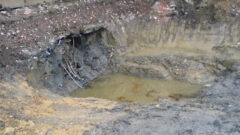
Robot performs first human eye surgery
Back in 2016, the University of Oxford’s Nuffield Department of Clinical Neurosciences began trialling a robotic system that could perform retina surgery. The results of the trial were published in the Nature Biomedical Engineering journal last month and confirmed that successful surgeries had been performed using the robot.
Precision surgery
Called the PRECEYES surgery system, the robot is manipulated by a surgeon and features a mobile arm to which different instruments can be attached. Its main benefit is that it eliminates the slight hand tremors that even the most seasoned human surgeons experience.
Twelve eye surgeries were performed, each of which required a membrane to be removed from the retina – a fairly routine procedure. Half were done manually and half with PRECEYES. The surgery requires a miniscule incision to be made just above the pupil, through which, in the traditional method, a flashlight is inserted, allowing the surgeon to manually continue the operation. In the procedures using PRECEYES, the robot was inserted and used to detach the membrane from the retina. The report states that in some cases, use of the robot made the surgery more effective.
A second phase of the trial required the robot to help dissolve under-retina haemorrhages that, left untreated, may have resulted in vision loss. These were also confirmed to be successful.
The next step
The effective use of PRECEYES means that the researchers can now consider more difficult operations, such as the delivery of a gene therapy to the retina. This is expected to begin in 2019. This surgery can be carried out manually on blind people, but is extremely challenging for patients who retain some vision. This is because human hands aren’t precise enough to pinpoint the specific spots on the retina that need the therapy.
In addition, it has been suggested that entirely new procedures could be performed, including unblocking blood vessels within the eye or injecting treatments into the optic nerve.
Research and development of robotic surgeons
Of course, PRECEYES isn’t the only robotic surgeon to be under development – other organisations are working on machines to address a range of surgical procedures. On the whole, they are considered slower than human surgeons, primarily because their operators need to take time to familiarise themselves with the instruments, but the gain in precision is generally agreed to be a huge advantage.
Projects involving the creation and trialling of such robots are often eligible for an R&D claim. Claiming for R&D tax credits enables the companies making the developments to enjoy a reduction in corporation tax, thereby gaining significant remuneration for their efforts.
Another financial avenue for new businesses involved with AI and robotics is start-up grants, which can be used for investment in equipment to help with the formulation and build of prototypes.
For further information about how R&D tax credits or start-up business grants can help your organisation, contact R&D Tax Solutions today.





